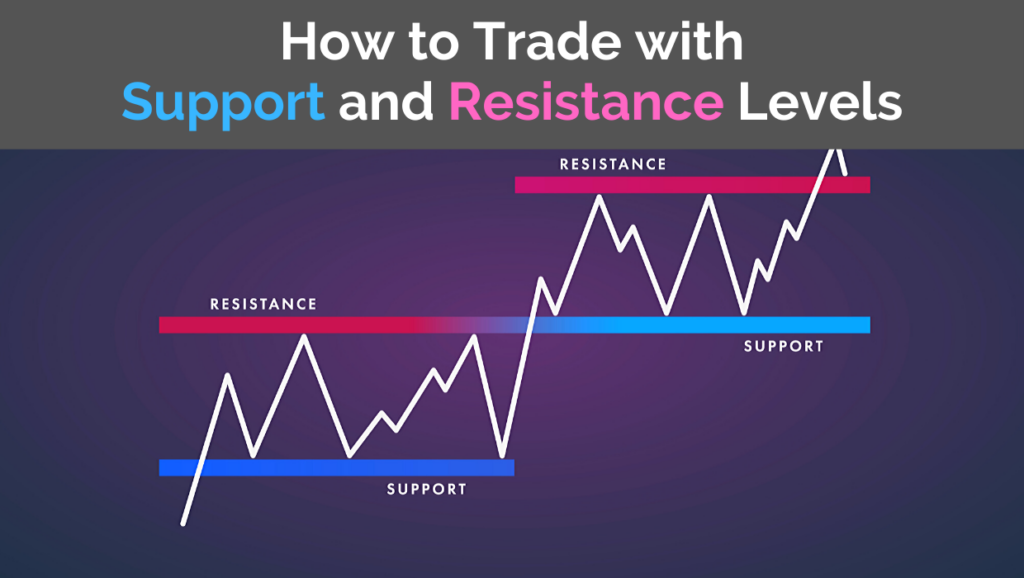
What is Support and Resistance Trading?
Support and resistance trading is a strategy that involves identifying key price levels where an asset historically struggles to move above (resistance) or below (support). These levels act as psychological barriers where price tends to reverse, consolidate, or break through based on market supply and demand.
Traders use support and resistance to predict price movements, determine entry and exit points, and manage risk effectively. This strategy is widely used in stocks, forex, and cryptocurrencies since price action naturally reacts to these levels.
How Support and Resistance Trading Works
1. Identify Key Support and Resistance Levels
- Support Level: A price point where buying interest is strong enough to prevent further declines.
- Resistance Level: A price point where selling pressure is strong enough to prevent further advances.
- Common methods to identify these levels:
- Historical Price Levels: Areas where price previously reversed.
- Moving Averages (50-day, 200-day): These act as dynamic support or resistance.
- Trendlines: Upward or downward sloping lines connecting multiple highs or lows.
- Fibonacci Retracement Levels: Key ratios that highlight potential reversal points.
2. Determine Entry and Exit Points
- Buying at Support: Traders enter long positions when price approaches a support level and shows signs of bouncing.
- Selling at Resistance: Traders enter short positions when price nears resistance and shows signs of rejection.
- Breakout Trading: If price breaks through a support or resistance level with strong volume, it may indicate the start of a new trend.
3. Use Confirmation Signals Before Entering a Trade
- Candlestick Patterns: Reversal signals such as hammer, engulfing pattern, or doji can confirm a level’s strength.
- Volume Analysis: A breakout with high volume increases the likelihood of a valid trend continuation.
- Momentum Indicators: RSI, MACD, and Stochastic Oscillator help confirm price exhaustion at key levels.
4. Manage Risk with Stop-Loss and Take-Profit Levels
- Place stop-loss orders slightly beyond support or resistance to minimize losses in case of false breakouts.
- Set profit targets at the next major support/resistance level to secure gains.
Example of Support and Resistance Trading
Example 1: Buying at Support on Apple Stock (AAPL)
A trader notices that AAPL has strong support at $140, where price has bounced multiple times in the past.
Trade Execution:
- Entry: The trader buys AAPL at $141 when price nears support and forms a bullish engulfing candlestick.
- Stop-Loss: Placed at $138 in case support fails.
- Profit Target: The next resistance level at $155.
- Exit: AAPL reaches $155, securing a $14 per share profit.
Example 2: Shorting at Resistance on Bitcoin (BTC)
A trader sees Bitcoin repeatedly failing to break above $45,000, indicating strong resistance.
Trade Execution:
- Entry: The trader shorts BTC at $44,800 when price shows a rejection at resistance.
- Stop-Loss: Placed at $46,000 in case of a breakout.
- Profit Target: The previous support level at $38,000.
- Exit: BTC drops to $38,000, capturing a $6,800 per BTC profit.
Pros of Support and Resistance Trading
- Clear entry and exit points – Defined levels make trade planning straightforward.
- Works across all timeframes – Can be applied to intraday, daily, or long-term charts.
- Effective for both trend-following and reversal strategies – Traders can use it for range trading or breakout strategies.
- Helps minimize risk – Stop-losses can be placed just beyond key levels for efficient risk management.
Cons of Support and Resistance Trading
- False breakouts can occur – Price may briefly move past a level before reversing.
- Requires patience and discipline – Traders must wait for confirmation before entering trades.
- Not suitable for all market conditions – Works best in trending or range-bound markets but less effective in highly volatile conditions.
- Subjective analysis – Identifying key levels can vary based on interpretation.
When Should You Use Support and Resistance Trading?
- If you prefer structured trading with clear risk-reward setups.
- If you want to combine price action with technical indicators.
- If you enjoy trading ranges, reversals, or breakout strategies.
- If you have the patience to wait for confirmation signals before entering trades.
Final Thoughts: Is Support and Resistance Trading Right for You?
Support and resistance trading is a foundational strategy used by traders of all skill levels. It provides clear price levels to base trades on, helping to define entry, exit, and risk management. However, traders must be aware of false breakouts and market volatility, which can challenge these levels.
For traders who prefer structured, technical trading strategies, support and resistance trading is an excellent method to master.


